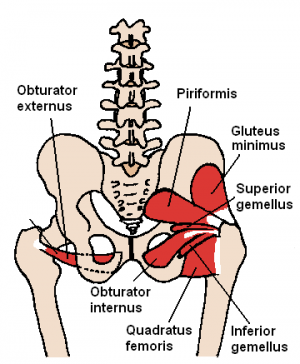Piriformis
Original Editor - Lucas Villalta
Top Contributors - Lucas Villalta, Vidya Acharya, Kim Jackson, Candace Goh, 127.0.0.1, Laura Ritchie, Evan Thomas, WikiSysop and Wendy Snyders;
Description[edit | edit source]
Piriformis is a flat muscle and the most superficial muscle of the deep gluteal muscles. It is part of the lateral rotators of the hip (obturator internus, superior and inferior gemelli, quadratus femoris, obturator externus, and gluteus maximus). It leaves the pelvis through the greater sciatic notch, until its fixation reaches the superior margin of the greater trochanter.[1] It has a pyramidal shape that lies almost parallel with the posterior margin of the gluteus medius.
Anatomy[1][edit | edit source]
Origin[edit | edit source]
- Anterior aspect of the sacrum at the level of about S2 through S4
- Sacrotuberous ligament
- Periphery of the greater sciatic notch
Insertion[edit | edit source]
- Superior and medial aspects of the greater trochanter.
Nerve[edit | edit source]
- Sacral plexus,5 and S1,2
Artery[edit | edit source]
- The arterial supply is from the inferior gluteal, superior gluteal and internal pudendal arteries, all branches of the internal iliac artery[2].
Function[1][3][edit | edit source]
- Lateral Rotation of the hip when it is extended (that is when in standing).
- Abduction of the hip when it is flexed.
- Aids slightly in tilting pelvis laterally.
- Also aids in tilting pelvis posteriorly by pulling the sacrum down towards the thigh[4].
Clinical relevance[edit | edit source]
The piriformis muscle can be used to locate the sciatic nerve. This nerve enters the gluteal region inferiorly to the piriformis. If the lateral rotators of the hip are tight they may exert pressure on the sciatic nerve, producing pain radiating into the lower extremity.[1][5] This is known as Piriformis Syndrome.
Another importance of this muscle is that it divides the gluteal region into a superior and inferior part. Therefore, it determines the name of the vessels and nerves that supply the area (e.g. the superior gluteal nerve and vessels emerge superiorly to the piriformis, and the inferior gluteal nerve and vessels emerge inferiorly to the piriformis).[5]
Assessment[edit | edit source]
Palpation[edit | edit source]
It may be palpable indirectly through the gluteus maximus into the greater sciatic notch.
Test[edit | edit source]
Treatment[edit | edit source]
Strengthening[edit | edit source]
Stretching[edit | edit source]
| [7] |
Manual techniques[edit | edit source]
References[edit | edit source]
- ↑ 1.0 1.1 1.2 1.3 Oatis, C. A., (2009). Kinesiology : the mechanics and pathomechanics of human movement (2nd ed). Baltimore : Lippincott Williams & Wilkins.
- ↑ Accessed from:https://www.kenhub.com/en/library/anatomy/piriformis-muscle on 14/08/18.
- ↑ Moore, K. L., Dalley, A. F., Agur, A. M. R. (2014). Clinically oriented anatomy (7th ed).Philadelphia : Lippincott Williams & Wilkins.
- ↑ Kendal, McCreary, Provance; Muscle Testing and Function with Posture and Pain;4th Edition; Piriformis muscle and its relationship to Sciatic Pain; Page No 365.
- ↑ 5.0 5.1 http://teachmeanatomy.info/lower-limb/muscles/gluteal-region/
- ↑ Robert Kelty Piriformis Strengthening Available fromhttps://www.youtube.com/watch?time_continue=72&v=9Gu7OjxbYKo
- ↑ stoneclinicPT Stretching: Piriformis Stretch Available from https://www.youtube.com/watch?time_continue=47&v=1fbFMCyRDGs
- ↑ Brent Brookbush Piriformis Static Manual Release (Soft Tissue Mobilization) Available from https://www.youtube.com/watch?v=f3vcmXWNJC0







